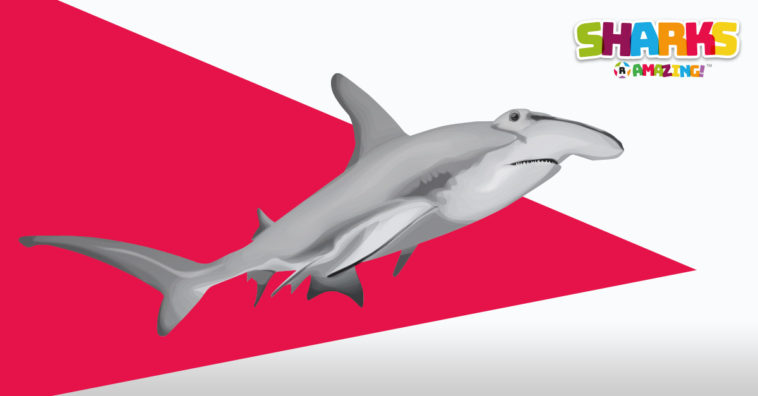With its unique shaped head, it is easy to see why they are called Hammerhead Sharks.
Why do hammerhead sharks look like that?
Their oddly-shaped heads could help them swim, or improve their vision, or any of a host of other things.
Reputation: The hammer-shaped head of hammerhead sharks improves their swimming performance. Or maybe it helps them handle prey. Perhaps it’s all about binocular vision. Or could it have something to do with enhancing the detection of electrical signals or smells?
Reality: There’s evidence for all of the above
Before we begin, let’s get one thing straight. There is not just one species of hammerhead. Taxonomists recognise eight different sharks that boast the characteristically flattened head.
If you are thinking that it doesn’t really resemble a hammer, you’d be right. Scientists refer to the shape of a hammerhead’s head as “cephalofoil”, because of its thin, wing-like appearance.
One possibility is that the flattened head enhances the shark’s swimming performance
This strange arrangement is a surprisingly recent evolutionary innovation. Whilst the first sharks appeared some 450 million years ago, molecular evidence suggests that the oceans have only harboured hammerheads for the last 20 million years or so.
“They are the youngest extant species of sharks,” says David Jacoby of the Zoological Society of London in the UK, who is studying the behaviour of scalloped hammerheads in the western Pacific.
But what possible advantage could this bizarrely-shaped bonce confer? There have been almost as many ideas as there are species of hammerhead.
One possibility is that the flattened head enhances the shark’s swimming performance.
In a study published in 2003, Stephen Kajiura and colleagues found that scalloped hammerheads made sharp turns much more often, and about twice as fast, as did conventionally-snouted sandbar sharks. The cephalofoil appears to help the hammerhead to plane its way through a turn with greater stability.
The hammerhead’s head can be used like a weapon
It has also been suggested that the head helps the shark to handle its prey.
It sounds like an odd idea, until you read this first-hand account from marine biologists studying stingrays in the Bahamas in the 1980s. A great hammerhead shark, about 3 m long, used its head to press a fleeing stingray to the sandy seafloor.
“The shark pivoted atop the ray and closed its mouth over the anterior margin of the ray’s left pectoral fin,” they wrote. When the ray made another attempt to escape, the shark used its head again “to restrain the stingray”, this time taking a bite from the other fin. The hammerhead’s head can be used like a weapon.
That’s impressive but maybe a bit unsubtle. Surely the flattened head has an effect on the animal’s vision?
In a 2009 study, Kajiura and his colleagues found that the wider the shark’s head, the greater the extent of its binocular vision – which is known to enhance the perception of depth.
When they swim, their head often moves from side to side
The winghead shark, whose head can be half as wide as its body is long, was easily the most impressive in this regard.
But vision is not the only sense that might be enhanced by the hammerhead’s cephalofoil. Like other sharks they can sense electromagnetic fields, and the electrosensory pores are more highly concentrated on the lower surface than they are for pointy-nosed sharks. That suggests hammer-shaped heads could work a little like metal detectors.
“When they swim, their head often moves from side to side,” says Jacoby. “This really helps them forage on the seabed and within the sand.”
Finally, there’s the sense of smell.
A 2010 paper presents evidence that sharks can tell which nostril receives an enticing odour first, and that they turn quickly in that direction. Hammerheads may be particularly good at this, because the hammer-shaped head means that their nostrils, known as “nares”, are positioned further apart.
“As a result of the wider spacing of the nares, hammerheads may be able to perceive a bilateral time difference at a smaller angle or at a greater swimming speed than an animal with a narrow head,” write the researchers. This may make them particularly good at tracking an erratic plume of fishy odour to its edible source.
The heads of hammerheads contain relatively big brains, which may be necessary for processing so much sensory information.
For their body size, the brains of scalloped hammerheads are particularly impressive, a fact that might account for the unusual sociality of this species. “They form these huge schools, often of several hundred individuals, that show quite polarized movements,” says Jacoby.
However, their social habits may make scalloped hammerheads more vulnerable to overfishing than other sharks. They are listed as endangered on the IUCN Red List of Threatened Species.
This article was originally published www.bbc.co.uk/earth/ in November 2015.




